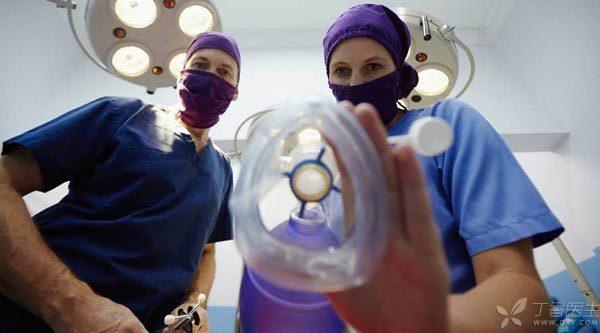
I have been strictly controlling my diet and actively exercising since I became pregnant, thus avoiding the disaster of gestational diabetes mellitus. However, just like Sun Wukong, who could not escape from the palm of Tathagata, I was still pregnant with a huge fetus.
During pregnancy, the pelvic size needs to be measured routinely. Professor Ouyang compared the pelvic measuring instrument between my two ischial tuberosity and immediately came to the conclusion that the buttocks are very large, but the [outlet] is very small.
Seeing that the [big truck] in my stomach may not be able to pass through the narrow birth canal smoothly, I decided to choose a convenient time for my family and doctors to undergo cesarean section directly between 39 and 40 weeks.
Temporary discharge of the role of obstetrician and gynecologist
Lying on the operating table of my hospital, as an obstetrician and gynecologist who has been able to perform cesarean section skillfully and knows that this is a seemingly simple but actually full of risks, I am not at all nervous or afraid.
I didn’t think about the possibility of dystocia or other dangerous postpartum complications, but I realized a kind of ease and ease that I had never had before. At last, I was able to temporarily unload the professional role of doctor, which has always been not without heavy responsibilities, and then I realized that I was too tired.
At that moment, I suddenly felt sorry for myself. Before the child was born, I had already shed tears unwillingly.

The big and fat girl was successfully fished out.
When my big and fat daughter was fished out of the uterus by Professor Ouyang, she looked very reluctant. She not only cried bitterly, but also bared her teeth and claws. A small hand grabbed the vascular forceps on the umbilical cord and said nothing but not to let go.
Professor Ouyang said with a smile while competing with her for pliers: “Fortunately, our doctor does not wear rings, necklaces or expensive watches on the operating table, otherwise you will have to be abducted by your girl.”
She has ruddy skin color, loud crying, a pair of small feet with kicking and kicking, a pair of small hands clenching fists, full of the tension of life.
The baby ate the first bite of milk in his life.
The child and I were sent back to the postpartum ward one after the other. My body was still in a semi-paralytic state after anesthesia, but my brain was fully awake. This is what cesarean section often calls “hemp but not drunk”.
When I confirmed that I could hold the baby smoothly, I asked my mother-in-law to hold my daughter to my chest and let her eat the first bite of milk in her life.
Generally, in about 3-6 hours, the concentration of anesthetic in plasma will be reduced by half, mainly concentrated in the nerves near the injection site to play a role. There are very few drugs entering the mother’s blood circulation, and even very few drugs entering breast milk through the blood-milk barrier.
However, in addition to necessary labor analgesia and episiotomy, local anesthetic drugs may be used for normal labor, and antibiotics are not required.
Therefore, no matter cesarean section or vaginal delivery, no matter which anesthesia method (including general anesthesia) is used, breast feeding will not be affected.
For antibiotics that need preventive use during cesarean section, every obstetrician will try his best to shorten the medication time and use a small amount of drugs that are effective enough for the parturient. Unless there are some special circumstances, the medication will be adjusted. Most of the drugs used are penicillin or cephalosporins that do not affect breast feeding.
Because of concerns about the use of narcotic drugs and antibiotics, it is totally unnecessary to persist in giving up breast-feeding, and the loss outweights the gain.
Don’t keep [medicine] away
Many mothers know that they cannot take medicine casually during breast-feeding, because they are worried that the medicine will be fed to their children through breast-feeding, so even if the wound hurts again, they will order themselves to grind their teeth and stick to it. This kind of forcing themselves to become [steel fighters] is totally unnecessary.
1. Pain killers can be used for wound pain.
If the parturient feels pain in the lateral incision wound, Or if the uterine contraction is too strong to cause lower abdomen pain, you can take an appropriate amount of painkillers, such as the most commonly used acetaminophen (also known as [paracetamol]), which can be bought in every pharmacy. Ordinary people can use it on their own if they have a headache and brain fever. It is one of the most widely used and safest over-the-counter drugs in the world.
Proper use of analgesic drugs under the guidance of doctors can help mothers to spend the sad days in the first few days after delivery more comfortably and smoothly, so as to recover their physical strength as soon as possible with a more relaxed mood.
2. Blind withdrawal is not advisable.
On the contrary, at the other extreme is a lying-in woman with her own health problems, who may stop taking drugs without authorization for the safety of breast milk and the opportunity to feed the world’s unique precious food rations to her children, which is even more undesirable.
Parturients with hypothyroidism still need to take thyroid tablets during lactation. Parturients with hyperthyroidism cannot stop taking drugs. Uncontrolled hypertensive parturients need to continue to take antihypertensive drugs. Parturients with basic diseases such as liver diseases, kidney diseases, heart diseases and autoimmune diseases cannot do without the support and assistance of drugs before and after delivery or during delivery.
The mother who is receiving medication, Never stop taking drugs without authorization in order to nurse your child. Once your disease is out of control or deteriorates, and your mother’s own safety is not guaranteed, I’m afraid you won’t be able to carry out breast-feeding to the end. Besides, for such a long time to come, how much a child needs a mother with physical strength, endurance and good physical condition to raise and accompany him.
Doctors will try their best to choose relatively safe drugs according to the physical condition of the parturient and the needs of breast-feeding, and strictly control the dosage of drugs, so as to ensure both the health of the parturient and the safety of breast-feeding.
Authorities such as the World Health Organization and the International Breastmilk Association have all called on mothers around the world to insist on breast-feeding until their children reach the age of two.
Summary
During this may be very long breastfeeding process, the mother will inevitably suffer from trauma, need stitches, or need X-rays due to toothache, or need chest radiographs, CT and MRI due to other medical needs, all of which will not affect breastfeeding.
It is totally unnecessary to worry too much about the use of narcotics, antibiotics or other drugs and persist in giving up breastfeeding. However, the use of various drugs during lactation must be carried out under the guidance of doctors in regular hospitals.
